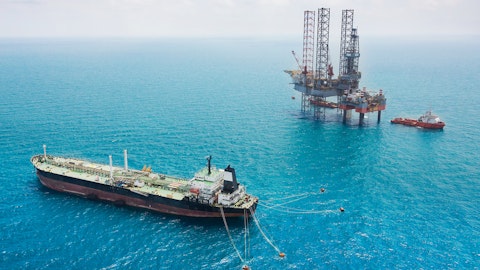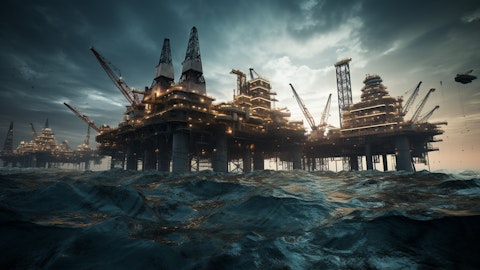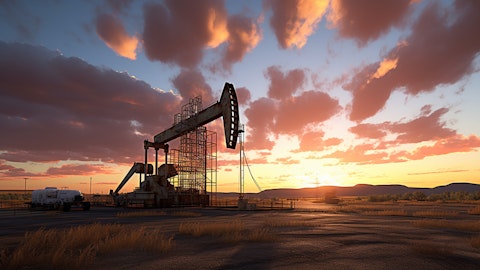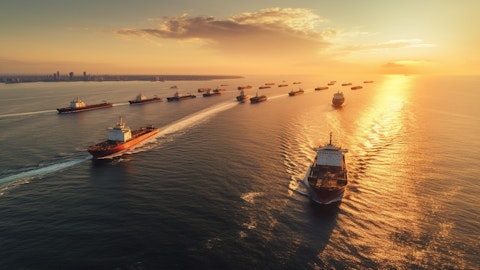So you have a participation of 11.7% in the fourth semester — quarter of 2023. This is not bad. That’s — well, you are in different countries. So I would like basically just to understand what are your expectations in terms of production of Permian in the US, considering that — as far as I understand, that will go down faster? And the last question, if it’s possible, otherwise, I understand because they asked me to ask just two questions. But considering the increase, for example, in the cost of — on that lifting cost of the — it’s above $13 in the fourth quarter. And considering the decrease of over 6% of the reservoirs, how do you justify that decrease of — a 90% decrease in the exploration and production CapEx for 2024, if you don’t take the average numbers of ’24, ’26 — 2024, 2026 that you published last December?
So these are my three questions and thank you for allowing me ask questions and good luck for 2024.
Ricardo Roa: Ricardo Roa — this is Andres. Thank you for your acknowledgment to our results for the fourth quarter production of the year we just finalized. First of all, to explain that, yes, the impairment of — the impairment of our assets has an impact on the results, close to COP0.9 trillion. Second, about the details, I’ll give the floor related to these elements of cost increases, our expectations of the Permian production in the next years. I’ll give the floor to Alberto Consuegra. He will share details.
Alberto Consuegra: Andres, good morning. About the Permian well, I would like to first give you a number that I think it’s relevant. Permian effectively pushes the production in the last quarter, but it’s not less what Cano Sur and Rubiales provide because as you already know, we — every year, we replace around 100,000 barrels per year due to the natural declination of the fields. So those three assets were — did great. They did the job. About the Permian, well, the goal is to keep growing our production. The plan for 2024 is to bring the production to close to 80,000, 83,000 barrels per day. And for 2025, it should be around 100,000 barrels because it is important for the contribution of the last acquisition, which is the Delaware area.
So Permian, very well. The important thing is to sustain the production within the country, and this is what — the effort that we’re going to do in terms of the CapEx for 2024 towards — all the way to 2026. And the fall in the CapEx is not as you are presenting it. When you look at 2024, the investment level that we will have in the upstream is of $300 million, $900 million, which is very similar to what we did in 2023. We were in $4,200 million. We have — it’s lower, but the greatest investment we had in 2023 was in the Permian. So our expectation is to continue with investment levels, similar to what — in Colombia, similar to the 2 previous years, 2022 and 2023.
Unidentified Company Representative: Andres, I would like to clarify that when I was talking about 2024 CapEx, I’m considering that annual average of the maximum and minimum range that you published, and I am comparing both the plan that you published in the previous year as well as what was executed this year. And the other thing, well, if you didn’t hear me well in the impairment, I asked specifically about the downstream. So that’s all I wanted to clarify, and excuse me for interrupting. Let me mention something before giving the floor to Milena about the impairment. She will talk of impairment. Andres, when you look at the CapEx distribution in 2024, the second part of the year is going to be affected due to the exploration investments, particularly on the offshore. So these could make a difference.
Milena Lopez: Hi, Andres. This is Milena Lopez talking about downstream impairment. Maybe to illustrate a little bit more that impairment topic, there are two components that I believe are important to consider. The first one is that when we are making the impairment analysis of our assets, these analyses are value exercises in the medium and long and short term. So they cannot be compared to a picture of our particular quarter. So when we look at the projection of the performance of the downstream, we see two specific things. First, an improvement in the availability of the refineries would allow us to have greater loads when we are making projections, forecast. And the second, which is more significant, is that when we look at the refining management in the mid and long term and we compare those what we see in the future with what we saw last year ago, we have better refinery margins.
This leads to a recovery of around $370 million at the downstream. Now another important topic that you have to consider when you compare these two mid- and long-term impairment comparisons is that well, generally that differentials of the products are cyclic during the year, particularly gas. So when we look at the numbers of the differentials of the fourth quarter, fees don’t reflect the annual average nor the perspectives on the mid and long term. So maybe that could explain the differential between what we see in the fourth quarter and what we see on the impairment exercise on the long term.
Andres Duarte: Thank you very much.
Operator: Juan Jose Munoz is online, and he’s going to ask a question. Mr. Munoz, you can ask.
Juan Jose Munoz: Good morning. Juan Jose Munoz from BTG Pactual. Thank you for the time. And just a quick question about the sales cost. In this quarter, why did you have a strong increase in the cost — sales cost that led the net margin very below what we signed of the first quarter? Was there something specific? And what are you going to do in the next quarters in order to recover that net margin that you previously had? Thank you.
Milena Lopez: So two components that I believe are important in understanding the quarterly cost, historically in Ecopetrol, in the fourth quarter, we you see costs that are above the other quarters because of greater execution as well as accrues. So if you look at the fourth quarter of last year, it was around 14% above the costs versus the third quarter. This year is even higher. We are seeing an increase of around 19% in cost, when we compare the previous quarter. So let me make a comparison of the fourth quarter of this year and the fourth quarter of last year to eliminate the cycles that will provide us a better perspective of what happens in the cost. So when we look at the variable costs — and then let me — I’ll tell you the fixed.
When we look at the variables, there are two components that impact variable costs when we make this comparison. Basically, we have, first, an inventory, which is significant comparing the number fourth quarter versus third quarter, the inventory has a cost of COP1.7 trillion, and this is due to a decrease on the cost or value of the inventory. And this has several components, a volumetric component because we had more sales, and a very important evaluation because when we evaluate, we give up — versus how we evaluate them. We have an exchange rate that is below COP740, around that. So we have a large decrease of the exchange rate. We also went from $86 to $82 per semester and a decrease in the product differentials. There’s a large decrease in the diesel differentials around above $20 and a fall of $7 in the gasoline differentials.
So this impact is COP1.7 trillion, and it is important that as we don’t have large numbers in the exchange rate differentials and the Brent, this is not a cost that should repeat it. So this has just happened in this quarter, I won’t repeat itself. Second impact in variable cost is the increase in power cost. Power cost increased in COP300 billion. So this is something that happened because in the third quarter of this year, we see an increase in this energy cost due to our exposure to the stock market and increase in the power and electric costs due to the phenomenon El Nino, which is something that we will — that will have an impact in the first quarter of this year because we still have high cost — power cost due to phenomenon, El Nino.
But at the end of this year, this could — should be corrected. This in terms of the variables that have an important situations. Now fixed cost. Fixed cost do have structural challenges that are larger. Basically in services hired by — for the operation, we see an increase of COP300 billion. And in maintenance in this semester, we — this quarter, we see greater maintenance and an increase in the inflation of this cost and an increase of COP100 billion. These two components that add around an increase of COP700 billion when we compare with the previous quarter last year, the same quarter last year. Yes, we have the inflationary aspects and challenges of cost challenges that with our efficiency plans, we are seeing how to adjust them. So yes, this is a temporary component and a long-term inflationary component that makes a distinction between both.
Juan Jose Munoz: Thank you, Milena.
Operator: The next question comes from Andres Cardona from Citibank. Mr. Cardona, you can ask now.
Andres Cardona: Thank you. Good morning to everyone. I have two questions. The first one is related with the production guide of 2024. 725,000 to 730,000 barrels. So how could you connect with the 758,000 barrels of the third — or the fourth quarter? Why are you — when are you going to explain this decline? And about the reservoirs, can you please explain in terms of the inflation, which are the components that vary the most and which was the magnitude? The certification of reservoirs of the previous year, understanding the price effect. There’s a price fall, and the price is relatively high historically. And I understand that — why? Why do you have this revision due to price effect from $82 per barrel?
Alberto Consuegra: Andres, Alberto Consuegra. Thank you for your questions. So I will begin with the production guide. And first, I’ll make reference to the Permian. Who — the behavior of Permian is historical. At the end of the year, we had — the production is always higher and then we have to live with two things. One, the normal decrease of the wells that are already in production and the next, perforation campaign. So the production of the Permian, which was a peak of 113,000 barrels per day of oil. When you see these in the production average for 2024, it’s between 80,000 and 83,000 barrels. So that’s the first impact. The second is with our liability management, which — or our risk management that we can attribute to the phenomena of El Nino that is related with the closure of — for example, or specifically Rubiales and Castilla fields.
When we have long droughts, the — these will be affected and what the corporate — environmental corporations do is they close the waterfalls gradually. This is what we are seeing right now. And we also need to know the physical safety situation that — and if you look at the history, usually during January to March, we see this in the previous years as well. So this risk management is also in our production vision. That is why we have that vision between 725,000 to 730,000 barrels on one hard side. In terms of the reserves, we need to mention something. I was mentioning in our previous intervention that yes, we do have an impact due to price and inflation. When we run our cash flows to the economical limit of the fields, we have an impact on that SEC price that is $15.5 per barrel plus the inflation.
So that’s the reason that we have to make a technical revision. It’s not related with the fact that right now, we are talking about a — the higher [indiscernible] in each of our fields. Nevertheless, it is true that the fact that we have a price that it’s unfavorable compared to 2022 and the inflation, well, it does affect the development plans of some fields that I already mentioned. And those fields will be outside of the norm of the 5 years, and they won’t in terms of reservoirs. They lose reservoirs compared to the previous year. So these are the effects that we see right now, Andres, and thank you for your questions.
Operator: Katherine Ortiz from Corredores Davivienda is going to ask a question. Ms. Ortiz, you can ask.
Katherine Ortiz: Good morning, everyone. I hope you can hear me well. Good morning. Thank you for providing me this space. I have a question related with the price stabilization fund of the fuels. We learned about the dividend proposal for 2024. And we have heard the Ministry — the Minister talking that this year, dividends — Ecopetrol capital dividends will not cross with the price stabilization fund. So I would like to know if you are clear about how you’re going to pay this amount? Especially because when we look at the budget availability and the financial — government’s financial plan, we cannot see that the Ecopetrol payment is going to be incorporated or if we decided that, at least, in 2024, they are not going to pay this money, and in that sense, well, which leverage indicators are you expecting in order for the — to close this year without considering the payment and including what you already mentioned with the — talked about with the government?
Thank you very much.
Ricardo Roa: Thank you, Katherine. Good morning. this is Ricardo Roa. Yes, effectively, one of the aspects that we have acknowledged about the national government support is the appropriation and the payment of the FEPC resources with the amount after the closure of 2022, COP36.7 million. These have been made, and that’s why we have the execution level of 97% in around COP27 trillion in 2023. For this year, this fund closes in [$20.5 million] (ph) of what was caused of the subsidy delivered to the demand of 2023 in gasoline and diesel. And resources at this time don’t come under the previous of the methodology of 2023, due to the payment of dividends donation, but because now they have a different methodology that I think Milena Lopez to explain.
Milena Lopez: Hi Katherine, this is Milena Lopez. So right. We, during 2024, we must receive COP20.7 trillion as a payment of FEPC by the national government. According to what has happened before and what is agreed with the government, each quarter, we cost the subsidies and they must be paid during the next 12 months. So we are going to receive quarterly payments from the government paying those debts. Which is — what is the different this year, in the past? We’ve done what we denominate, crossing the dividends, which is an accounting movement. We just exchange the invoice that we — the government is going to pay us with the one that we need to pay for dividends. So we don’t give or receive anything. But this year, we’re going to receive a quarterly payment from the government.
And we, on our side, on the date that we must pay the dividends, we will be paying the dividends to the nation. So that’s what it means that we are not going to — crossing accounts. It’s important to highlight that these — well, we need an approval from the Board meeting. This is going to be submitted to voting. This includes a dividends to the Nation of COP11.3 trillion, less than of that COP20.3 trillion that we are going to receive from FEPC. So the net amount is going to be received in cash payments that improve the liquidity position of our company.
Katherine Ortiz: Thank you very much.
Operator: Let’s begin with questions in English. Bruno Montanari from Morgan Stanley has a question. Mr. Montanari, you can ask now.





